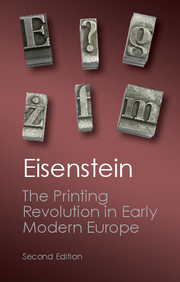Book contents
- Frontmatter
- Contents
- List of Illustrations and Maps
- Preface to the Second Edition
- Introduction
- THE PRINTING REVOLUTION IN EARLY MODERN EUROPE
- PART I THE EMERGENCE OF PRINT CULTURE IN THE WEST
- PART II INTERACTION WITH OTHER DEVELOPMENTS
- 5 The Permanent Renaissance: Mutation of a Classical Revival
- 6 Western Christendom Disrupted: Resetting the Stage for the Reformation
- 7 The Book of Nature Transformed: Printing and the Rise of Modern Science
- 8 Conclusion: Scripture and Nature Transformed
- Afterword: Revisiting the Printing Revolution
- Selected Reading
- Index
5 - The Permanent Renaissance: Mutation of a Classical Revival
from PART II - INTERACTION WITH OTHER DEVELOPMENTS
Published online by Cambridge University Press: 05 October 2013
- Frontmatter
- Contents
- List of Illustrations and Maps
- Preface to the Second Edition
- Introduction
- THE PRINTING REVOLUTION IN EARLY MODERN EUROPE
- PART I THE EMERGENCE OF PRINT CULTURE IN THE WEST
- PART II INTERACTION WITH OTHER DEVELOPMENTS
- 5 The Permanent Renaissance: Mutation of a Classical Revival
- 6 Western Christendom Disrupted: Resetting the Stage for the Reformation
- 7 The Book of Nature Transformed: Printing and the Rise of Modern Science
- 8 Conclusion: Scripture and Nature Transformed
- Afterword: Revisiting the Printing Revolution
- Selected Reading
- Index
Summary
We all know … that down to the fifteenth century all European books were pen written and that ever since that time most of them have been printed. We know likewise that in that same fifteenth century Western culture laid off its medieval characteristics and became distinctively modern. But we are quite unable to conceive realistically any connection between these technological and cultural changes except that they happened in the same period.
This statement, which was made by Pierce Butler in 1940, describes a situation which seems current even now. Although the relationship between technology and culture in general has been the subject of a growing literature, the more specific relationship between the advent of printing and fifteenth-century cultural change has not yet been explored. This is partly because the very act of drawing connections is not as easy a task as one might think. Butler goes on to refer to an “intimate connection” which becomes apparent “the moment our thought penetrates through bare facts,” but I must confess I cannot imagine just what connection he had in mind. Although the shift from pen-written book to printed one may be taken as a known fact, it is not the kind of fact that can be said to “speak for itself.” As previous chapters suggest, a complex ensemble of many interrelated changes was involved.
When one turns to the other side of the equation, matters are no less complicated and even more obscure.
- Type
- Chapter
- Information
- The Printing Revolution in Early Modern Europe , pp. 123 - 163Publisher: Cambridge University PressPrint publication year: 2012



